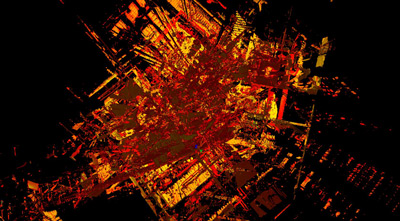Few things in laser scanning cause more foolishly absolute statements than the subject of targets. While most of us started our laser scanning careers using targets, there are very few that still use them the way we were taught during our first dealer workshop or training course. This, in and of itself, is not a bad thing. The trial and error approach to laser scanning has been integral to the success of the industry as a whole. After all, most of us are stereotypically early adopters and we know that with that moniker come certain drawbacks/opportunities. The foremost being the lack of a well worn path.
As scanners have become less expensive and more common, I have found myself registering and modeling other people’s data besides my own. I appreciate both the work and the unfiltered view it provides of other scanner operator’s methods. Perhaps this is why I do not hold to many hard and fast rules when it comes to target strategies. I’ve seen a lot of things I would not have tried be successful. When it comes to targets, I don’t claim to have all of the answers (in fact, I’ve a lot of questions I’d like help with…), but there are a few truisms that I feel compelled to share. After all, there is no use watching someone else beat their head against a wall I’ve already found a hole through!
- You can’t alter the fundamentals of Geometry.
The single most common problem that I see in data I process is bad target geometry. I don’t care if you have 30 common targets between adjoining scanworlds, if they are all in a straight line on one wall we’ve got a problem! Think of your point cloud as a tent. where do you put the stakes to hold down a tent? In a line down the middle? Sure! Especially if you like watching all four corners flap in the breeze! You want all of your data to be controlled, so place your control (targets) at the edges in each direction. Don’t forget that we don’t have the benefit of gravity as our tent example does. While you are placing your targets in all four directions, place them at varying heights in relation to the scanhead as well.
- You can’t alter the fundamentals of Physics.
If you haven’t captured your target with sufficient density for me to derive the target centroid, it might as well not exist. If I can’t find your target in the point cloud, it doesn’t count. If it is only in one scanworld, it doesn’t count. I’m good but I’m not a magician.
- You should know your reason for using targets.
There are other ways to register scanworlds. I prefer targets for various reasons but I’ve still used Cloud to Cloud, object-based registration and even scanner based traversing on occasion. I just think that there is a time and place for each. If you can’t define the reason for your choice you might want to revisit that decision.
- Your registration results are not really a statement of the accuracy of your point cloud.
A registration report is a statement of the error (typically the absolute mean error) between centroids of targets that were collected from two or more collection positions. It does not mean that every point in your point cloud is accurate to the distance listed as the absolute mean error in your registration report. It seems that a lot of people either don’t understand this or think, “the only way I can be proven wrong is if someone comes behind me with a more accurate instrument and that’s not going to happen…,” so they don’t worry about it. Without even considering the ethical issues, the reality is that with poor target geometry the next guy might not need a better instrument to find your error; and a better instrument is probably only a year or two away.
- There is no such thing as a free lunch.
Occasionally we get a software or hardware upgrade that significantly improves our workflow. But, most of the time, any major “efficiency” is simply a trade off of work to someone else in the field to finish assembly line. I am not saying that is a bad thing. The hourly costs of a two-man scanning crew is quite different from a person sitting at a workstation. Occasionally, tradeoffs can uncover previously unrealized profits. Just be honest with yourself about the fact that any change in target methodology will ripple through the entire system as far as your budget is concerned.
- Sometimes it seems like a bunch of voodoo.
While scanning is definitely a scientific endeavor, part of it is still an art. If you do this long enough, some question you pose will make its way back to the creators of the tools that you are using. Eventually, if they are honest, they will admit that they don’t know why the thing they created is behaving the way that it is. The next statement is usually something like, “We’ve never seen it do that.” Understanding is powerful, but experience is king. Welcome to the bleeding edge.






